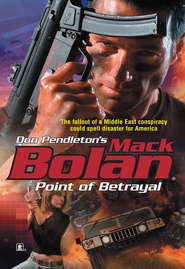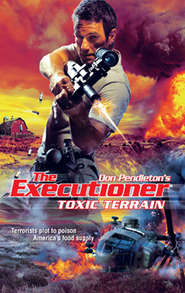По всем вопросам обращайтесь на: info@litportal.ru
(©) 2003-2025.
✖
Hell Night
Автор
Год написания книги
2019
Настройки чтения
Размер шрифта
Высота строк
Поля
Tom Glasser was still in the parking lot, still glancing occasionally into the bank. The men around him appeared curious about his blacksuit. The stretchy, skintight material was nothing like the navy blue Battle Dress Uniforms they wore, and they were asking questions that Glasser looked like he was ignoring.
“I’ve already got my back covered, Mr. President,” he said.
Brognola had remained silent during the conversation because he’d had nothing to add to it. Now, he did. “You’re talking about the recent blacksuit graduate you’re with at the moment, Striker?” he asked Bolan.
“I am,” the Executioner said. “He’s a good man, the training is still fresh in his mind and he’s just proved to me that he can cross that bridge from classroom to practical application.”
“He’s covered, then, Mr. President,” Brognola said. “The blacksuit he’s talking about is with the Kansas City PD, and he graduated with honors at the top of his class. I can step back into my Justice Department role, make a call to Kansas City, get the man released for special assignment with us and then line him up with phony Department of Justice identification just in case it’s helpful.”
“You do that, Hal,” the Man said. “And, Striker, you’ve got the direct number into the Oval Office, as well as the one in my living area. If you need anything else—day or night—give me a call.”
“Will do, sir,” Bolan replied.
“Then I guess that’s it,” the President said. “So if you’ll excuse me, I’ve got a few other matters to attend to.” Without another word, he hung up.
“You still there, Hal?” Bolan asked.
“Still here, big guy.”
“This really is one of the oddest arrangements I’ve ever been around,” the Executioner said. He felt himself shaking his head in awe. “Hamas and the Rough Riders. Who’d have figured on that one?”
“It is odd,” Brognola said. “But it may turn out to be one of the deadliest combinations we’ve ever faced, too.” The Stony Man director paused for a moment, then said, “You want to know what pisses me off almost as much as the terror these groups inflict, Striker?”
“Sure.”
“The name these Nazi militants have taken,” Brognola said. “The Rough Riders.” He paused yet again to clear his throat. “Teddy Roosevelt was one of my favorite presidents.”
“I suspect he’s rolling over in his grave right now, Hal. He’d be the first to shoot every Nazi or Hamas terrorist he saw.”
“Bully,” Brognola said, using one of Roosevelt’s favorite expressions. Then he went almost straight into another. “Want some advice from old Teddy on this mission, Striker?”
“Sure, Hal. Hit me with it.”
“Walk softly,” Brognola quoted, then slightly altered the rest of Roosevelt’s other famous saying. “And carry your big gun.”
The director of Stony Man Farm’s Sensitive Operations Group clicked off as Bolan felt his hand slide down his ribs to the grips of the .44 Magnum Desert Eagle.
3
The Learjet had been gutted behind the cockpit. Four bolted-down beds—two on each side of the craft—took the place of the passenger seats. Between both pairs of bunks was a circular table with four chairs, all likewise fastened to the cargo area’s deck. The walls of the aircraft were covered by lockers not unlike those you might find in a high-school football dressing room. But instead of holding helmets, shoulder pads and jerseys, these lockers were stacked with a variety of weapons, ammunition and other equipment.
Only two of the four beds were in use, however, as Jack Grimaldi, Stony Man Farm’s ace pilot, guided the plane over the Atlantic.
Grimaldi turned and briefly glanced behind him. Bolan was asleep and breathing easily. On the bed next to him, the new blacksuit graduate, Tom Glasser, was doing the same.
They had changed out of their combat gear as soon as the Lear had leveled off, hanging their blacksuits, black nylon web belts and other equipment in the lockers, then changing into civvies. Now Bolan lay on his back, sleeping in a light-toned off-white shirt, and stone-colored slacks. The shoulder-holster system-containing the Beretta 93-R machine pistol and extra magazines had been slung over the shirt. He had transferred the mammoth .44 magnum Desert Eagle to a form-fitted, Concealex plastic belt holster on his right hip. Extra magazines for this gun, as well as his combat knife, rode on his left hip.
A light, camel-colored suede sport coat—which he would use to cover all of the weapons—had been hung over the back of one of the chairs at the table.
Stony Man Farm’s top pilot checked his instrument panel and saw that the Lear was nearing the coast of France. He hated to do it but he had no choice but to awaken Bolan and this new blacksuit, Glasser. Turning yet again, he raised his voice slightly. “Okay, guys,” he said. “Welcome to the land of wine, cheese, beautiful women and a nasty attitude toward us Americans.”
The Executioner’s eyes opened at once. Glasser had evidently been in a deeper stage of sleep. He didn’t move until Bolan got up off the bed, maneuvered his way around the table and chairs and shook him by the shoulder. Finally, the Kansas City SWAT commander opened his eyes, sat up and turned to place his feet on the deck of the Learjet.
“Where are we?” he asked.
“France,” Grimaldi said over his shoulder. “Where nine out of ten people wish they’d never given us the Statue of Liberty.”
Bolan chuckled. “The French aren’t all bad, Jack,” he said.
“I know that,” Grimaldi came back. “I only said ninety percent were.”
Bolan chuckled again, letting Grimaldi know that the Executioner was aware that it was all just talk—the Stony Man Farm pilot was no more bigoted against the French people then he himself was. Grimaldi continued to watch as Bolan returned to his bunk, sat down and began lacing on a pair of low-cut hiking shoes.
In the rearview mirror, Grimaldi saw Glasser tie the laces of a similar pair of shoes. The SWAT man was wearing a double shoulder rig with a matching pair of Browning Hi-Power pistols. But they were not the time-honored and much copied 9 mm version that had been invented by Robert Browning in 1935. Glasser’s sidearms were two .40-caliber S&W semiautomatic pistols. The beefed-up slides appeared to be coated with some kind of nonabrasive, rust-resistant finish, while the lower parts of both semiautos were made of brushed, nonreflective stainless steel.
The Executioner finished tying his shoes, stood up, walked to the seat next to Grimaldi, then sat down. “How far out are we?” he asked.
“Another twenty minutes or so to Paris,” Grimaldi said. As Bolan fished for his seat belt, found it, then buckled himself in, Stony Man Farm’s flying ace noted that the Executioner had put on the suede sport coat. His weapons were now completely hidden from view.
A second later, Glasser appeared between the seats, standing just behind them but being forced to bend low beneath the cabin roof. The Kansas City SWAT man was dressed in casual tourist garb, as well, wearing creased and pleated denim slacks and a light cotton OD green sport coat over a white sport shirt. With a hand braced on both seats, he looked at Bolan. “You’ve got the address where we’re supposed to meet these guys?” he asked. “And their names?”
The Executioner nodded.
“Can I see them?”
Bolan shook his head, then turned to look at the SWAT man before tapping his temple with a trigger finger. “They’re up here,” he said.
And that, Jack Grimaldi thought, summed up the Executioner better than any other single gesture ever could. He had the fingers with which to pull the triggers. And the brains to organize and set up operations.
Not to mention memorizing addresses and names.
Grimaldi glanced at his controls again, then reached for the microphone clipped to the panel in front of him. A few moments later, he had clearance to land.
The President himself had cleared the way through French customs, and signing their names on a clipboard handed to them by a small, slender man with a curling mustache who looked very much like fictional detective Hercule Poirot was all it took to get their passports stamped.
“Well,” Grimaldi said before Bolan and Glasser walked on through the turnstile into France, “good luck. Although I know you don’t depend on luck.”
“A lot of dead men did.” The Executioner smiled as he shook Grimaldi’s hand. “You’ll be with the plane in case we need to go someplace in a hurry?”
“I will,” Grimaldi confirmed. “Just give me about five minutes’ lead time.”
THE RENTED BROWN MERCEDES blended in perfectly with the rest of the Parisian traffic as Bolan guided it along the street that followed the Seine. Glasser—who had never been to Europe in his life—gawked like a schoolboy seeing his first female breast.
Bolan smiled inwardly. That was one of the things he liked about Glasser. The man didn’t try to hide his thoughts or reactions to things. He was what he was, and didn’t pretend to be anything else. So when Glasser’s mouth fell open at the sight of the Eiffel Tower, the Executioner saw it as an honest emotion that came from viewing something he’d heard about but had never thought he’d actually see.
Amid honking horns, other cars cutting them off, and obscene gestures flung out of windows, Bolan guided the Mercedes over the bridge toward Notre Dame. Glasser seemed as impressed with the ancient cathedral as he had been the Eiffel Tower.
“What are those little monsters on top called again?” he asked the Executioner.











